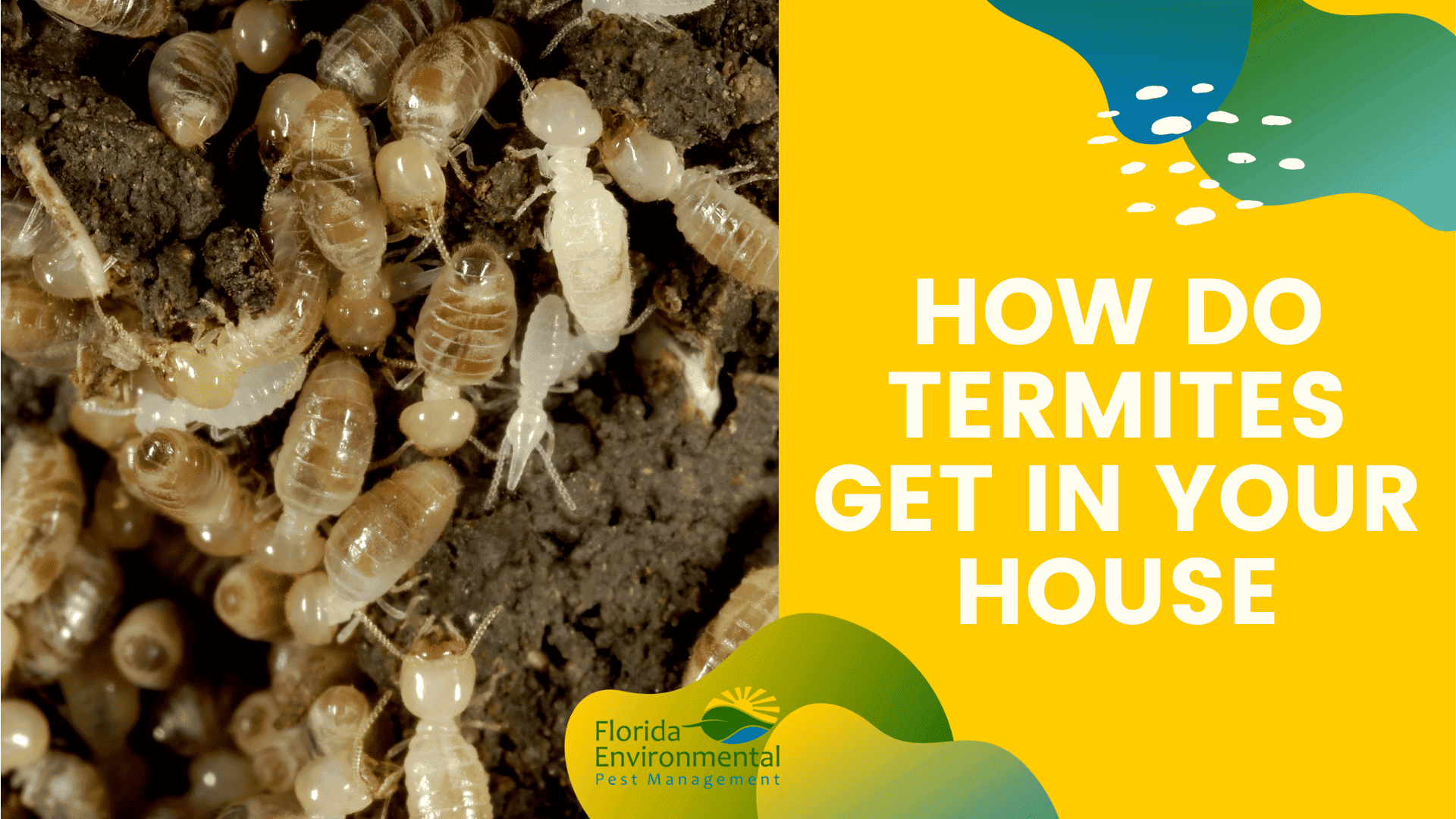Termites, those tiny creatures that scuttle around silently, may seem harmless at first glance. However, these seemingly insignificant insects have a destructive nature that can wreak havoc on your home. As a homeowner, you may have wondered, “How do termites get in your house?”.
Termites have several entry points through which they can gain access to your home. Understanding these entry points is essential in devising effective strategies for termite prevention and management.
Once you figure out how termites can infiltrate your space, you can then learn how to get rid of termites in your home and prevent extensive damage.
How do termites get in your house?
Termites have several ways through which they can gain access to your house. These tiny insects are adept at exploiting even the smallest vulnerabilities in your home’s defenses. Here are some common entry points for termites:
1. Cracks in the foundation
Termites can enter your house through small cracks or gaps in the foundation. These cracks may develop naturally over time or be a result of settlement, weathering, or other factors. Termites can squeeze through these openings and make their way into the structural components of your home.
2. Gaps around plumbing and utility lines
Termites can exploit gaps or openings around plumbing pipes, utility lines, or other conduits that enter your house. These gaps can occur where pipes or lines penetrate the foundation or walls. Termites can follow these entry points and access the interior of your home.
3. Wooden structures in direct contact with the soil
If you have wooden structures, such as deck posts, porch steps, or door frames, that are in direct contact with the soil, termites can easily gain entry. They can tunnel through the soil and directly access the wood, using it as a food source and potentially establishing a colony within.
4. Crawl space vents
Termites can also enter your house through vents in crawl spaces. These vents are designed to provide ventilation but can inadvertently provide an entry point for termites. If the vents are damaged, improperly installed, or not adequately screened, termites can squeeze through and infest the area.
5. Roof and attic
In some cases, termites can access above-ground structures by building mud tubes. These tubes are protective tunnels made of mud and saliva that termites construct to navigate from the ground to above-ground structures. Termites can build mud tubes along exterior walls, foundation walls, or even inside walls to reach areas such as the roof or attic.
What Attracts Termites in the House?
When trying to figure out what attracts termites in the house, there are a few factors to consider. Some of them are:
1. Moisture
Termites are highly attracted to moisture as it provides them with the necessary hydration to survive. Houses with moisture issues, such as damp areas, water leaks, or poor drainage, become prime targets for termites.
Termites are particularly attracted to damp areas, such as basements, crawl spaces, or areas with poor ventilation. These environments provide the moisture termites need to survive and thrive. Moisture also contributes to the decay of wood, making it easier for termites to feed on cellulose-based materials.
2. Wood
Termites have a voracious appetite for wood and other cellulose-based materials. Any wooden structures in your house, such as beams, floorboards, or furniture, become attractive food sources for termites. They can quickly devour and cause significant damage to untreated or exposed wood.
3. Cellulose-based materials
Besides wood, termites are drawn to other cellulose-rich materials commonly found in homes, such as paper, cardboard, and certain types of insulation. These materials provide termites with a readily available food source and can attract them to various areas of your house.
What Are The Early Signs of Termites?
Here are some early signs of termite activity that homeowners should watch out for:
1. Discarded wings
Winged termites, also known as swarmers or alates, are reproductive termites that leave their colonies in large numbers to establish new colonies. After a termite swarm, you may find discarded wings near window sills, doorways, or other entry points. These wings are a clear indication of termite activity and the potential presence of an established colony nearby.
2. Mud tubes
Termites construct mud tubes, also called shelter tubes or termite highways, as a means of protection and moisture control. These tubes are composed of soil, wood particles, and termite saliva and are often found along foundation walls, exterior walls, or other surfaces. If you notice mud tubes on your property, it is a strong indication of termite presence and activity.
3. Hollow-sounding wood
Termites feed on wood from the inside out, hollowing it as they consume the cellulose. If you tap or knock on wooden structures, such as beams, floorboards, or furniture, and they produce a hollow or papery sound, it may indicate termite damage. This is a sign that termites have already infested the wood and caused significant deterioration.
4. Tiny holes in wooden structures
Termites create small entry and exit holes in wooden structures as they tunnel through the material. These holes are typically round and may be accompanied by small piles of sawdust-like frass nearby. If you come across these tiny holes or frass, it is a strong indication of termite activity and potential infestation.
5. Sagging or distorted wood
As termites consume wood, they weaken its structure, causing it to sag or become distorted. If you notice sagging floors, warped doors or windows, or buckling wooden structures, it may be a result of termite damage. These physical changes in the wood can be a clear sign of an ongoing termite infestation.
6. Presence of mud or dirt in unexpected places
Termites require moisture to survive, so they often bring soil or mud into their feeding sites. If you find mud or dirt in unexpected places, such as on walls, floors, or furniture, it could be a sign of termites actively constructing their mud tubes or foraging for food.
It’s important to note that termite infestations can go unnoticed for extended periods, as termites work silently and hidden within the structures of homes. Regular inspections by homeowners and professional termite inspections can help detect early signs of termites and enable timely intervention.
If you observe any of these early warning signs, it is recommended to consult with a professional termite exterminator. They can accurately assess the situation, confirm the presence of termites, and provide appropriate treatment options to eliminate the infestation.
Why do termites suddenly appear?
Termites suddenly appear in a house due to various factors like the maturity of nearby termite colonies, changes in environmental conditions, construction activities, and transfer of infested materials.
As the colony expands, it produces reproductive termites called swarmers or alates. These winged termites leave the colony in large numbers during swarming season to establish new colonies. If the swarming occurs near your house, it can lead to a sudden influx of termites inside.
Do termites spread from house to house?
Yes, termites can spread from house to house, especially if neighboring houses have termite infestations. Termites primarily spread through underground tunnels, known as galleries, which they construct to forage for food and establish new colonies.
Other ways through which termites spread from house to house include:
- Shared soil and proximity
- Infested building materials
- Flight of swarmers
- Tree branches and vegetation
- Plumbing and utility lines
It’s important to note that if neighboring houses have termite infestations, there is a higher risk of termite presence in nearby properties. Therefore, it is crucial to take preventive measures and conduct thorough termite inspections in your own house to minimize the risk of termite spread.
What are the long-term effects of termites?
If left untreated, termites can have long-term effects on a property. Their relentless feeding and nesting activities can cause extensive damage to wooden structures, leading to these potential long-term effects:
1. Structural weakening
Termites feed on cellulose, which is abundant in wood. Over time, as termites tunnel through wooden components of a building, such as beams, flooring, and furniture, they weaken the structure. This can result in sagging floors, sinking foundations, and compromised load-bearing capacity, posing a serious safety risk.
2. Compromised integrity of wooden structures
Termites can hollow out wooden structures from the inside, leaving only a thin outer layer intact. This hidden damage can go unnoticed for years, making it difficult to detect until the structural integrity is severely compromised. Doors, windows, wooden frames, and other wooden elements can become fragile, unstable, and prone to collapse.
3. Costly repairs
Repairing termite-induced damage can be a significant financial burden. Depending on the extent of the infestation, repairs may involve replacing damaged wood, reinforcing weakened structures, and treating the property to prevent future infestations. In severe cases, entire sections of a building may require reconstruction, leading to substantial costs and inconveniences.
4. Decreased property value
Termite damage can significantly reduce the value of a property. Potential buyers may be deterred by the presence of termites or the history of infestations. Even if the damage is repaired, the stigma associated with termites can impact the marketability and resale value of the property.
5. Health risks
While termites primarily target wood, their activities can create conditions conducive to mold growth. Dampness resulting from termite infestations can lead to mold formation, which can trigger respiratory problems and allergies in occupants. Additionally, the presence of termites and their fecal matter can release airborne particles that may cause irritation or allergic reactions in sensitive individuals.
To get rid of termites, you can consult with a pest management company to apply some control methods like chemical treatments, fumigation, physical treatments, etc in your home.
Hire Florida Environmental Pest Management for Effective Termite Control
Protect your home from the devastating damage caused by termites by taking proactive measures with Florida Environmental Pest Management. With our expertise in termite prevention and control, you can safeguard your investment and have peace of mind knowing that your home is protected from these voracious insects.
Termites pose a significant threat throughout South Florida, where the warm and humid climate provides an ideal environment for their proliferation. Various termite species, including the eastern subterranean termite, Formosan termite, Asian termite, and dry wood termite, thrive in this region. They collectively cause over $5 billion in damages to homes across the United States each year.
Don’t let termites wreak havoc on your property. Homeowners’ insurance typically doesn’t cover termite damage, making it necessary to take prompt action. By scheduling a Free Termite Inspection from Florida Environmental Pest Management, you can proactively assess your home’s vulnerability to termites and develop a tailored prevention and control plan. Contact us today to schedule your Free Termite Inspection and take the first step toward protecting your investment.





